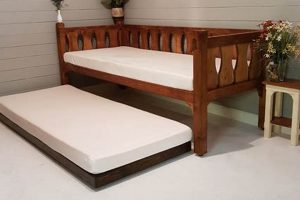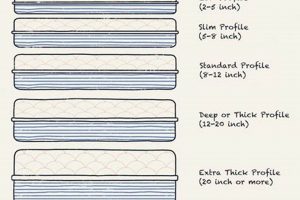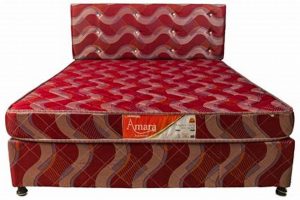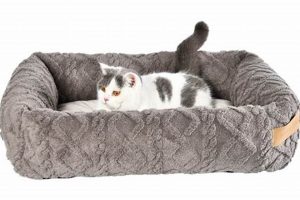The process of inspecting a sleeping surface for the presence of small, nocturnal insects that feed on human blood is a crucial aspect of maintaining a healthy and pest-free living environment. Careful examination involves looking for visual signs of the pests themselves, their shed skins, or fecal matter, primarily along seams, tufts, and folds.
Regular surveillance of bedding offers significant advantages, including early detection, prevention of widespread infestations, and reduced exposure to bites, which can cause skin irritation and allergic reactions. Historically, such monitoring has been vital in controlling outbreaks and minimizing potential health consequences associated with these pests.
The following sections will detail specific techniques, tools, and areas to concentrate on during an effective examination, providing guidance on confirming an infestation and implementing appropriate remedial actions.
Inspection Guidance
The following recommendations provide a structured approach to confirming or ruling out an infestation within sleeping surfaces.
Tip 1: Use a Bright Light: A strong flashlight or other focused light source is essential for illuminating crevices and dark areas where these pests typically hide.
Tip 2: Focus on Seams and Folds: Carefully examine the edges, seams, and folds of the mattress, as these areas provide ideal harborage for the pests and their eggs.
Tip 3: Inspect the Underside: Do not neglect the bottom surface of the mattress; carefully turn it over and scrutinize it, paying close attention to any tears or damage.
Tip 4: Check the Box Spring: Extend the examination to the box spring, inspecting its fabric covering and wooden frame for signs of infestation. Remove the dust cover on the underside for a more thorough examination.
Tip 5: Look for Fecal Spots: Dark, reddish-brown spots, which are digested blood, are a strong indicator of their presence. Look for these stains on the mattress, bedding, and surrounding furniture.
Tip 6: Search for Shed Skins: These pests shed their skins as they grow. Finding translucent, exoskeletal remains is another key sign of their presence.
Tip 7: Be Patient and Thorough: A careful inspection requires patience. Move slowly and systematically, ensuring that every area is adequately examined.
These guidelines should facilitate a more effective search, contributing to early detection and timely intervention. Early identification increases the likelihood of successful eradication and reduces the potential for a widespread issue.
The subsequent segment of this document will address the confirmation of infestations and the determination of necessary corrective measures.
1. Visual inspection
Visual inspection is a primary method in the process of checking for bed bugs in a mattress. It involves a detailed examination of the mattress surface, seams, folds, and crevices for the presence of live insects, shed skins (exuviae), fecal spots, and eggs. The effectiveness of other methods relies on the initial, careful observation that visual inspection provides. For instance, identifying a single fecal spot during visual inspection prompts more intensive scrutiny of the surrounding area.
The absence of visual evidence does not necessarily confirm the absence of an infestation; however, its presence is a definitive indicator. Practical application includes using a bright flashlight to illuminate potential hiding spots and a magnifying glass for close examination of small details. Commercial pest control professionals routinely begin their investigations with visual inspections to determine the scope and severity of a possible infestation.
A thorough visual inspection requires patience and attention to detail. Challenges may arise in cluttered environments or mattresses with dark fabrics, potentially obscuring visual cues. While it represents a foundational component of the overall strategy, visual confirmation serves as the critical first step leading to more targeted and effective remedial action.
2. Seam examination
Seam examination is a critical component of inspecting a mattress for these pests. The seams of a mattress provide a protected environment, offering harborage due to their narrow crevices and relative darkness. These areas are often undisturbed, allowing populations to establish and thrive. Due to the physical structure of the seam, it offers an ideal location for egg deposition and provides shelter for nymphs and adults. This makes seam examination a priority when attempting to determine the presence of these pests. In the context of a comprehensive mattress inspection, the failure to thoroughly examine seams can lead to a false negative result, delaying necessary treatment and allowing the infestation to worsen.
Consider a scenario where a mattress exhibits only minimal staining on its surface. Without a focused inspection of the seams, the source of the staining might be missed, leading to an incorrect assumption that the mattress is free of pests. A detailed seam examination, however, might reveal a cluster of insects and fecal matter hidden within the fabric folds, confirming the infestation despite the lack of obvious signs elsewhere. This highlights the practical significance of prioritizing seam examination within a comprehensive inspection protocol. Another example is when a light infestation is suspected because of sporadic bites and itching during sleep, but no pests can be seen on the surface of the mattress; in such instances, the seams are one of the first place to inspect.
In summary, seam examination is not merely a procedural step, but a critical diagnostic element in determining the presence of these pests within a mattress. While other areas should not be neglected, the high likelihood of infestation within seams makes their detailed inspection a foundational aspect of the overall strategy. Thorough seam examination reduces the risk of overlooking infestations and contributes directly to effective pest management outcomes.
3. Edge scrutiny
Edge scrutiny, when determining the presence of insects within a mattress, refers to the meticulous examination of the mattress’s perimeter. These edges frequently present multiple layers of fabric and complex stitching, providing ideal concealment. The proximity of the mattress edge to bed frames and bedroom furniture also makes it a common transit point for these pests, further increasing the likelihood of infestation in these areas. Thus, examining the edges is an essential part of a thorough inspection.
The absence of proper edge scrut
iny can lead to misdiagnosis, delaying appropriate intervention. For example, if only the flat surfaces of a mattress are examined and the edges are ignored, a nascent infestation confined to the mattress perimeter might be missed. Later, these could grow and spread. In practical application, edge scrutiny involves carefully lifting the mattress edges and using a flashlight to illuminate the areas where the top and bottom fabrics are joined. A magnifying glass can assist in the detection of eggs or nymph stages. This approach is integral to achieving an accurate assessment.
In conclusion, edge scrutiny is not merely a superficial step but a key investigative component. Challenges such as limited visibility or tight spaces may necessitate the use of specialized tools or techniques. By prioritizing thorough edge scrutiny, the probability of early detection is enhanced, leading to more effective and less costly pest management strategies.
4. Underneath surveillance
Examination of the underside of a mattress is a crucial, yet often overlooked, aspect of determining whether an infestation exists. This area provides an undisturbed, dark environment that is particularly attractive to these nocturnal insects. Consequently, the absence of underside surveillance significantly increases the likelihood of a missed diagnosis, leading to delayed treatment and potential exacerbation of the problem. Furthermore, the coarse texture and intricate stitching often found on the underside of mattresses offer ample harborage for both adults and their eggs. A direct correlation exists between thorough examination of this area and the accuracy of the overall assessment.
In practical terms, a flashlight and a mirror may be necessary to conduct effective underneath surveillance. Given the potential for dust accumulation and limited visibility, a systematic approach is essential. For example, slowly move across the underside in a grid pattern, paying close attention to any stains, cast skins, or live insects. Consider a scenario where an individual experiences unexplained bites but finds no evidence on the mattress’s surface or seams. Upon conducting thorough underside surveillance, clusters of insects and fecal matter are discovered, confirming the source of the problem and enabling targeted treatment.
In summary, underneath surveillance constitutes an integral component of a comprehensive inspection strategy. Challenges related to accessibility and visibility can be mitigated through the use of appropriate tools and methodologies. Prioritizing this aspect of mattress examination enhances the probability of early detection and contributes to the success of subsequent eradication efforts. Failure to conduct thorough underneath surveillance undermines the efficacy of the entire inspection process.
5. Stain identification
Stain identification is intrinsically linked to the effectiveness of mattress inspections, serving as a prominent indicator of infestation. The presence of dark, reddish-brown or black stains on a mattress, box spring, or surrounding bedding often signifies digested blood excreted by the insects. These stains result from their feeding activity and provide tangible evidence even when the pests themselves are not immediately visible. As a component of a comprehensive inspection, stain identification can alert individuals to the potential presence of these insects, prompting a more thorough investigation.
A scenario illustrates this connection: an individual experiencing unexplained skin irritation may initially attribute it to allergies. However, upon closer examination of the mattress, dark spots are observed along the seams. This finding prompts a more targeted inspection, revealing the presence of the insects themselves and confirming the source of the bites. Without the initial recognition of the stains, the infestation might have gone unnoticed for a prolonged period, leading to a more widespread problem. Another practical application lies in differentiating the stains caused by these pests from other common household stains, such as spilled liquids or mold. The characteristic color and pattern of the fecal spots serve as a key distinguishing feature.
In summary, stain identification is an indispensable aspect of determining the presence of these insects during mattress inspections. Recognizing and interpreting these signs contributes significantly to early detection and timely intervention. Challenges may arise in situations where stains are faint or obscured by dark fabrics, necessitating the use of appropriate lighting and magnification. The ability to accurately identify stains enhances the efficacy of the overall inspection process and supports informed decision-making regarding pest management strategies.
6. Egg detection
The detection of eggs constitutes a crucial aspect of determining the existence and extent of an infestation during mattress inspections. Their presence confirms active reproduction and indicates a potentially expanding population, even if adult insects are not immediately apparent.
- Appearance and Location
Eggs are typically small, oval-shaped, and pearly white, often found in clusters within mattress seams, tufts, and crevices. The glue-like substance with which they are attached makes them difficult to dislodge. Identifying these characteristics is paramount during mattress inspections.
- Size and Visibility
Due to their small size (approximately 1mm in length), eggs can be difficult to spot with the naked eye, particularly on mattresses with dark fabrics or intricate patterns. Effective detection often requires the use of magnification tools and a bright light source.
- Implications for Infestation Severity
The number of eggs discovered can provide insights into the duration and severity of the infestation. A large number of eggs suggests a well-established and actively reproducing population, necessitating immediate and comprehensive treatment measures.
- Challenges in Identification
Eggs can be easily confused with dust particles or other debris commonly found on mattresses. Accurate identification requires careful examination and a thorough understanding of their distinct characteristics, including shape, size, and color.
The detection of eggs is directly linked to the effectiveness of inspection protocols. By prioritizing the identification of eggs, individuals enhance their ability to detect infestations early, enabling timely intervention and preventing widespread problems. Omission in egg detection undermines the purpose and efficacy of checking for these pests within mattresses.
Frequently Asked Questions
This section addresses common inquiries concerning the detection of these insects within mattress structures, providing clarity on inspection procedures and associated concerns.
Question 1: How frequently should a mattress be inspected for these pests?
A mattress should be inspected periodically, ideally during routine cleaning or whenever unexplained skin irritation or bites are noticed. Individuals residing in multi-unit dwellings or those who fre
quently travel should conduct inspections more regularly.
Question 2: Is visual inspection alone sufficient to confirm the absence of an infestation?
Visual inspection, while a crucial first step, may not be sufficient on its own. These insects are adept at hiding, and early infestations may present minimal visible signs. A comprehensive inspection should also include examination of seams, crevices, and the underside of the mattress.
Question 3: What tools are recommended for effective mattress inspection?
Essential tools include a bright flashlight, a magnifying glass, and a stiff-bristled brush. These items facilitate thorough examination of mattress surfaces and hidden areas, aiding in the detection of insects, eggs, and fecal matter.
Question 4: Can these insects infest a mattress even if it is encased in a protective cover?
While mattress encasements offer a degree of protection, they are not foolproof. These insects can still infest mattresses through openings in the encasement, such as zipper closures or tears. Regular inspection of both the encasement and the mattress is advisable.
Question 5: What are the key differences between these insect bites and other insect bites?
These insect bites typically appear as small, red, itchy welts, often arranged in a line or cluster. However, these bite characteristics can vary significantly between individuals and may resemble bites from other insects. Definitive diagnosis requires identification of the insects themselves.
Question 6: If a mattress inspection yields negative results, does that guarantee the absence of these insects within the dwelling?
A negative mattress inspection does not guarantee the absence of these insects in the dwelling. They can infest other areas, such as bed frames, headboards, and nearby furniture. A comprehensive inspection of the entire sleeping area is necessary to rule out an infestation definitively.
Early detection through proper inspection is a pivotal factor in effective control and mitigation. This knowledge can allow homeowners to start control measure immediately.
The subsequent section details the methodologies employed in confirming these pests and determining if professional services are required.
Conclusion
The process of scrutinizing a mattress for indications of infestation is critical for maintaining a healthy living environment. Successful implementation of examination protocols hinges on employing visual inspection, seam examination, edge scrutiny, underneath surveillance, stain identification, and egg detection. Mastery of these techniques is paramount for timely identification and intervention. This allows homeowners to make a decision on taking control measure immediately.
Vigilance and attention to detail remain essential in mitigating the potential impact of such infestations. The diligent application of these inspection techniques constitutes a proactive approach towards safeguarding the well-being of the dwelling and its occupants. Consistent application of inspection protocols supports a living place free of this infestation.


![The Ultimate King Size Beds with Mattress [Guide] Organic & Natural Mattress Buyer’s Guide: Non-Toxic Sleep Solutions The Ultimate King Size Beds with Mattress [Guide] | Organic & Natural Mattress Buyer’s Guide: Non-Toxic Sleep Solutions](https://mattressworldpa.com/wp-content/uploads/2025/07/th-7104-300x200.jpg)


![Best Bed Car Mattress [Guide] Mobile Beds For Cars Organic & Natural Mattress Buyer’s Guide: Non-Toxic Sleep Solutions Best Bed Car Mattress [Guide] Mobile Beds For Cars | Organic & Natural Mattress Buyer’s Guide: Non-Toxic Sleep Solutions](https://mattressworldpa.com/wp-content/uploads/2025/07/th-7101-300x200.jpg)

